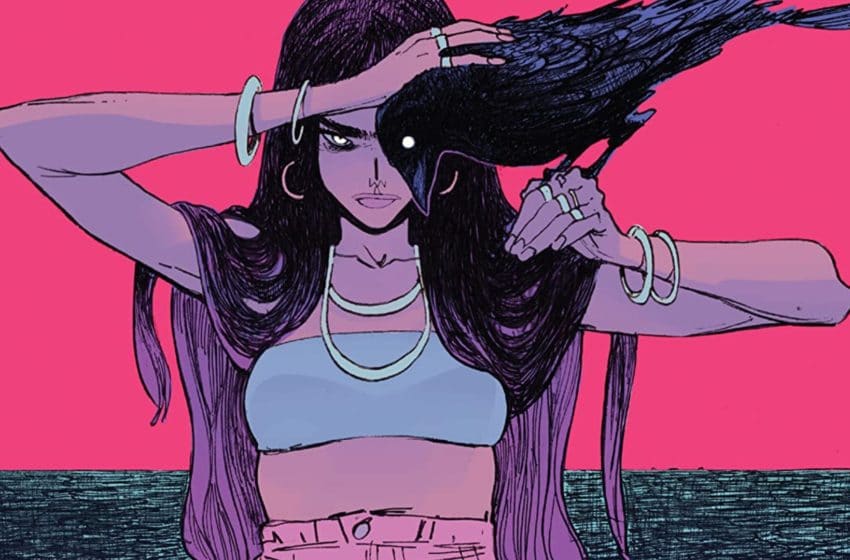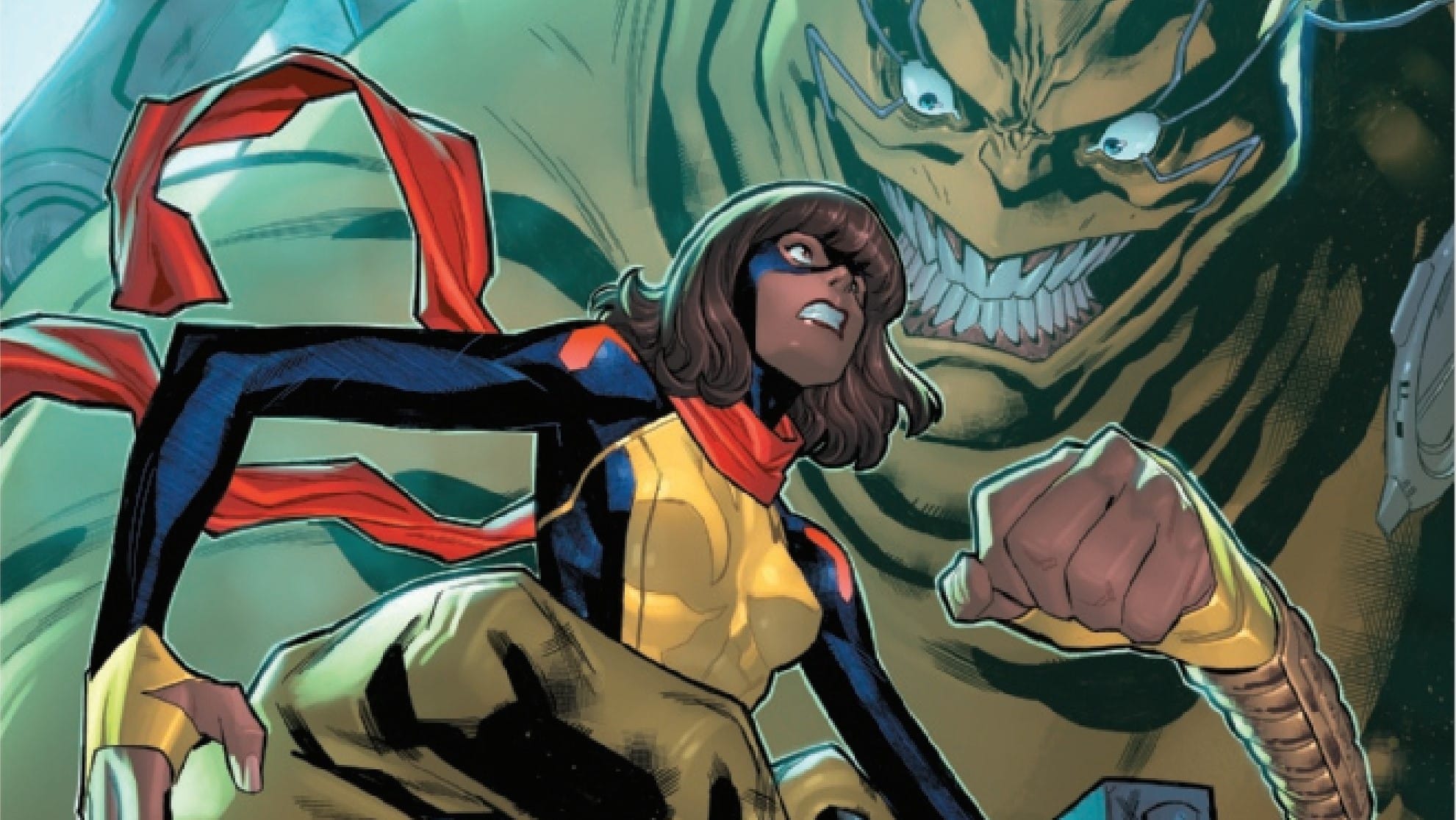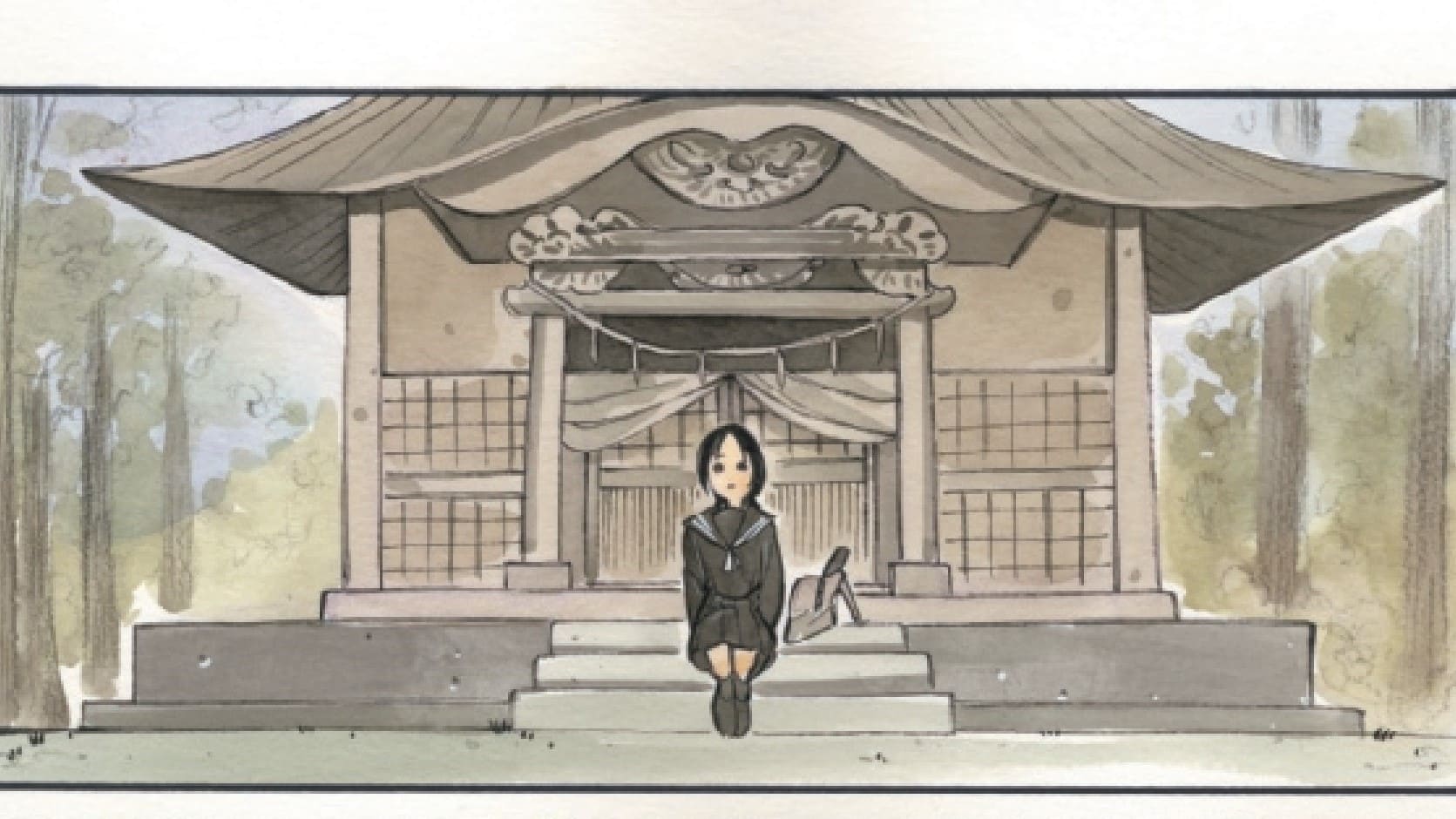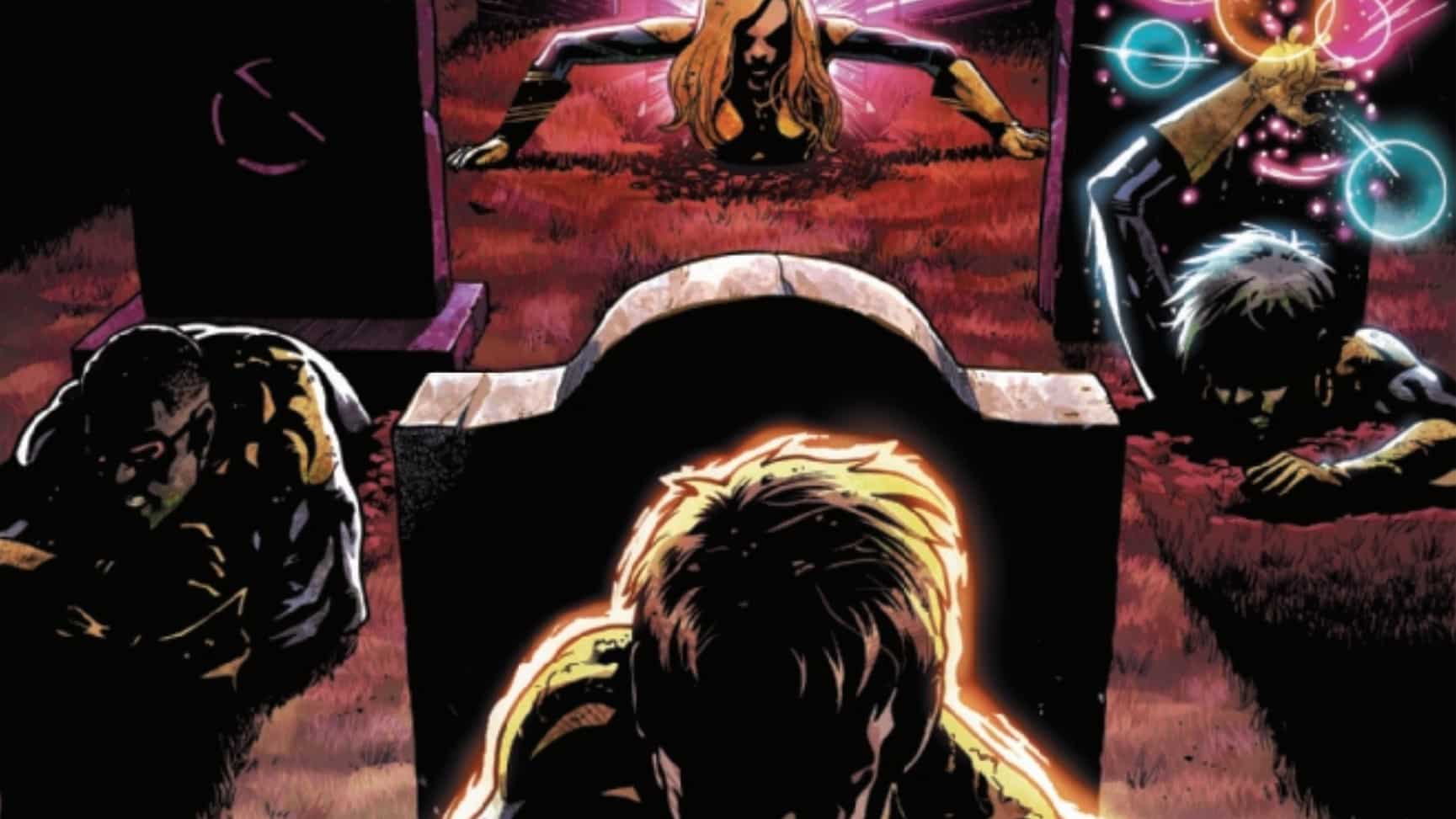Death, in her new avatar of the mortal Laila Starr, is doing her damnedest to prevent the invention of immortality that would put her out of a job — only an inconvenient death means she’s lost the child prophesied to bring it all about. The child in question, Darius Shah, has had eight years to learn about life and the world. A chance encounter at a funeral teaches them both about what death means to the mortals left behind, in The Many Deaths of Laila Starr #2, written by Ram V, illustrated by Filipe Andrade with color assist by Inês Amaro and lettered by AndWorld Design.
Andrea Ayres: Armaan! We are back to talk about issue #2 of The Many Deaths of Laila Starr, and there’s a lot to discuss. The work Filipe Andrade and Inês Amaro do is striking here, as it was in the first issue. The beautiful washes of vibrant purples, blues and oranges. The issue feels like a sunset, bittersweet and melancholic. “The Knowledge of Crows” struck me even more than it might have, considering the images pouring into the U.S. out of India over the past few weeks. What were your initial impressions?
Armaan Babu: It’s good to be back, discussing what may be one of my favorite comics of the year, for what may just be one of my favorite single issues of the year so far. This issue hit home for me in more ways than one, and I don’t know how to summarize it in an opening paragraph. It’s a powerfully relevant issue. I’m eager to get right into discussing it.
We Don’t All See the Same Sky

AA: The issue opens with the avatar of Death talking to a funeral crow named Kah. Kah carries the souls of the recently deceased in exchange for rice from mourners. The pair sit on the edge of a building overlooking Mumbai. Laila is forlorn. She has no idea how to find Darius — the child who will discover the key to immortality — in such a massive city.
The flashes of Mumbai in the opening few pages feel like the blink of an eye. Each time we close an eyelid, something new draws our attention. It is a constant hum of life. I’d love to know what you thought about our introduction to Kah and another view of Mumbai here?
AB: I love me a talking animal guide, and Kah’s delightful. I like how comfortable they are with Laila — just hopping onto her shoulder, ready to show her around the city. I’ve only been to Mumbai myself a handful of times, but the city leaves an impression — one the art brings to life surprisingly well.
So, there’s something weird I’ve noticed about the skies in America.
They’re different.
At least, it feels that way. Daylight in the States is not the same as the daylight you get here. I don’t know what it is or how to describe it. All I know is that the way Andrade and Amaro color Mumbai? They get it. You describe that constant hum, there are so many memories here.
There are panels where the color choices bring blasts of Mumbai heat rising off the page. Or the cool coastal twilight breeze is coming in from the ocean. The cozy details in the art, like how the steam rises from cooking pots or the trash piles up in the streets, mixed with those colors — there are some panels I can practically smell.
We don’t just get a glimpse of it from Kah and Laila’s perspective here, either. We move from them to catch up with our prophecy child, Darius Shah, and the day he ran away from home to get to an important funeral. There’s a flashback to how Darius met Bardhan, the man whose funeral this is. What were your first impressions of Bardhan and his story here?
AA: I love you bringing up how the skies are different. The sun gives a city a language, feeling and mood. We don’t all see the same sky. What I feel so deeply about this issue is how you describe it; this is the work of people who get it. Now, let’s dive into the story of Darius and Bardhan.
Don’t Forget Me

AA: The image of Bardhan — his tall, lanky limbs, and the extreme hunch of his back as he works. Bardhan is described as a man with “granite skin” and “tired amber eyes.” Ram’s language pierces.
The panel reminds me of “The Gleaners” (Jean-Francois Millet, 1857) and “The Stone Breakers” (Jean-Baptiste-Camille Corot, 1849). They are artworks that depict the human body at work: the deep bow of the back, the tension of muscles and the pain of physical labor. It’s not often depicted in popular culture. We do not frequently see the complex nature of back-breaking work.
Bardhan has a name and a story. His humanity extends beyond the mere physicality of his labor. It is both heartbreaking and touching. The glimpses of joy he shares with Darius are panels I will reflect on for some time. How did you feel about their story?
AB: That is beautifully put. Seeing the traditionally overlooked in society appears to be a theme of this issue. I love how you’ve illuminated what makes Bardhan’s story so important.
The flashback brought up a lot for me. Darius’s childhood summers with Bardhan are spent on the outskirts of Mumbai. There he is amongst mango, jackfruit and sapodilla. Here they are known as chikoo. I have never read a comic more familiar to me. This was my childhood. I have extended family that lives in Dahanu, a town on the outskirts of Mumbai, where I’ve spent many wonderful summers on my uncle’s chikoo farm. There are differences, of course, but it is amazing how well Andrade evokes those summers. It brings that childhood nostalgia creeping in.
I’m fascinated by Bardhan. He’s drawn larger than life, as if straight from myth. It feels like his exaggerated proportions are us seeing him straight through Darius’ eight-year-old-eyes.
So you mention how he is named, let’s talk about names for a bit. After the last issue, I dove into full research mode regarding Hindu mythology. The mythology presented in The Many Deaths of Laila Starr is only loosely connected. It led to me finding out that Pranah (name of this series’ God of Life) just means “Life.” The way Bardhan’s name was presented felt significant, so I looked that up and asked around. Bardhan is a Bengali surname that can mean a number of things, which most notably include “Growth” and “Progress.” This is fitting for a gardener who was pivotal to Darius’ early development.
I looked up all the other names not counting the gods taken from actual myth. With names like Brahma and Agni, it looks like Ram is having a lot of fun with these. The name “Darius” refers to someone who possesses much goodness, or someone who holds fast to that which is good. It can also denote royalty, which Ram doubles down on with his last name, Shah, which means “king.”
As for our Starr character, Laila herself? I can’t find a meaning for Starr, aside from the pun I just used. “Laila” means “Night” or “Darkness.” It is a name given to girls born at night. I don’t know what time of day the original Laila Starr was born, but she died at night — and Death was born into her body at night, as well. As I mentioned last issue, Death is based on the Goddess Kali. The name can be translated to “She Who is Death.” Perhaps more relevantly, “She Who Is Black.” “Kali” is the female version of the word for black. The only characters who don’t have significant names are the ghost MunMun and the crow Kah. Interestingly enough those are the beings that only Laila sees.
AA: I love that you did a deep dive into the names. What is beautiful about this comic and what keeps pulling me back are those evocations of nostalgia. I have a different cultural experience, growing up in the Midwestern suburbs, but childhood’s universality is precisely that. Play, curiosity, exploration are part of the childhood experience no matter where you are.
Parents try to mold and shape children’s curiosity, but it does not know a linear path. Children are pliable and malleable. They see adults as adults allow themselves to be seen. Bardhan is honest and authentic in his relationship with Darius. He speaks to the child using straightforward language. It contrasts with how other adults talk to him. I’m thinking of his mother, who explains why Bardhan is not allowed jackfruit. “Because they are not for him, child, and you shouldn’t encourage him to think so.”
Parents set unspoken boundaries and rules for how children come to view others in our world. This scene is one of those small, seemingly inconsequential moments that end up shaping Darius’ life. What did you think of the moment when Darius gives Bardhan the jackfruit? I’d also like to know how you felt about the intertwining of Bardhan, Laila, Kah and Darius’ stories?
AB: We have Darius, a prophecy child. “Darius was not one for simply accepting the rules.” This is a line for someone who is going to change the world. It feels like his act of compassionate rebellion is there to show how he becomes the person meant to end the universal truth, that death comes for all.
The comic then returns us to the present. Bardhan’s funeral is held at the Walkeshwar Temple. Kah explains to Laila what death is like to mortal eyes. This is a new perspective for Laila. There, on the beach, we meet a devastated Darius, who ran away from home to attend the funeral. Laila doesn’t recognize the child she once tried to kill, and the two have a conversation about death — whether gods can die and the importance of memories left behind.
Darius and Laila are both approaching death from different directions — each brought to the funeral by their respective guides of a sort. At the age of 8, this is probably the first time Darius has truly encountered death. For Laila, it’s something she’s dealt with in the billions. It seems to be the first time she understands what it means. The avatar of Death and the bringer of Immortality, meeting in the middle at sunset, where day meets night, at a funeral, where the living meets the afterlife. It’s a profound moment, one enhanced by the wistfulness of twilight skies and the quiet comfort Laila and Darius give to each other.
One thing that interests me — Kah theorizes that as a god, Death found it easy to kill mortals, that she probably doesn’t even remember them as the centuries pile on. As a mortal, though, those memories bind, the weight of a life taken is so much more, and that’s likely why the mortal Laila couldn’t kill baby Darius. We’ve seen a lot of stories of gods who’ve been turned mortal. I don’t know if this has been previously explored. What do you think of this approach?
Feel the Weight

AA: The funeral scenes are some of the most evocative of any comic I’ve read. It speaks to the impact of restraint on the part of the creative team here.
What is interesting to me here is that as a god, Death cannot pick out the individual lives she has taken. Through Darius and Bardhan, however, we can feel the emotional weight and toll of death and memory. It reminded me of how people have a mental block when it comes to mass casualty events. The more death, the more we dissociate from it. This is a mental process known as psychic numbing. It is often coupled with the cognitive bias known as compassion fade. These issues have been, and continue to be, one of the most challenging components of telling the story of COVID-19. It is why news organizations, at times, try to personalize the many dead using small vignettes.
We are both Laila and Darius. We dissociate from the dead if we choose. Yet we are all part of death’s story. Whether we like it or not. The actions we take to honor the dead tie us to our past, present and future. What I will take away from this issue more than anything is the sensitivity and deference paid to the dead. The color of marigolds, a group of people in collective mourning. COVID-19 has robbed so many of us of mourning.
When I consider this issue in contrast to the images of India coming into Western-media outlets State-side, I pause. Light-skinned reporters stand near funeral pyres with bodies tied and bound. It is not that these images should go unseen, but I wonder if it is all just a spectacle for the living? Without memory or knowledge of these people, what does a single body mean to me? Am I able to grasp the weight of that body or its significance? I’m still unpacking my feelings. I am curious to know your thoughts about well, all of this?
AB: I wanted it noted that I don’t think that BOOM Studios, the comics creative team or anyone else involved with this comic is responsible for the timing of this — but the fact is, this is a comic book about death, set in India, that’s coming out at a time when death is at the forefront of every Indian’s mind. As the pandemic rages worse than ever before, we’re not just running out of hospital beds and oxygen cylinders — we’re running out of burial grounds and cremation sites from which to say goodbye to our dead. Even where it’s possible, it’s not safe to have fully attended funerals.
I have very little idea what the news coverage on this has been like for the rest of the world. There are thousands upon thousands more personal stories across social media, in phone calls to friends, in requests for medicines, hospital beds and oxygen. It’s still very personal here. The sheer overwhelming force of what’s happening is a good example of the psychic numbing. It doesn’t get any less numb just because we’re in the thick of it. It can be hard to know what to do in the face of this loss.
The funeral scene featured in this comic is not just beautiful, it is at once a comforting and painful explanation of why rituals of death matter. I was raised Christian, so I’ve never been to a Hindu funeral, but there is a universality to the way that Kah describes death rituals. No matter what you believe, no matter what you practice, death rituals all have one thing in common: revering the memories of the departed — keeping something back for the land of the living.
I’m OK with the coldness of the media. It’s a whole model based on numbers over stories — when you’re reporting on such a global scale, sometimes that’s all it can be.
It’s up to stories like this one to remind us what’s important. I am grateful for a story that talks about death in a way that means so much and is so beautifully told.
Of course, memories do more than tug at one’s heartstrings — here, the memories of the dead are tugging at Laila, sensing the Death goddess inside and wanting to give her a taste of her own medicine. Another death, another time skip, and Laila wakes up in Pranah’s room, 12 years from the funeral, at a time when Darius would be a young man of 20. What do you think this could mean for what’s coming?
AA: Death can be a weight. It can pull us under if we don’t acknowledge its physical and emotional toll. Humans try to do this through the use of rituals, rites and memories. Still, life goes on, and we forget. Death and pain are blunted. To some extent, it must be for us to progress. I reckon if Laila Starr is about anything, it is about the need to have an ongoing relationship with the dead. I imagine issue #3 will bring us closer to that relationship than ever before.
Musings from Mumbai
- Current tally for the deaths of Laila Starr: 3
- My (Armaan’s) only quibble with the art? The neck feathers of the crows ought to be visibly gray. It’s the easiest way to be able to tell them apart from ravens.
- Oh god, those variant covers are gorgeous. I love all three covers, but the Jeff Dekal one is so absolutely stunning it’s gotten me (still Armaan) to change my lockscreen for the first time since I got my phone in 2016.






